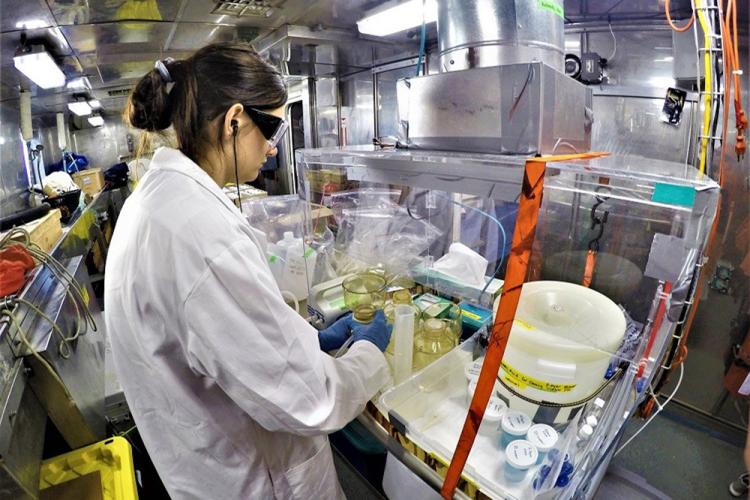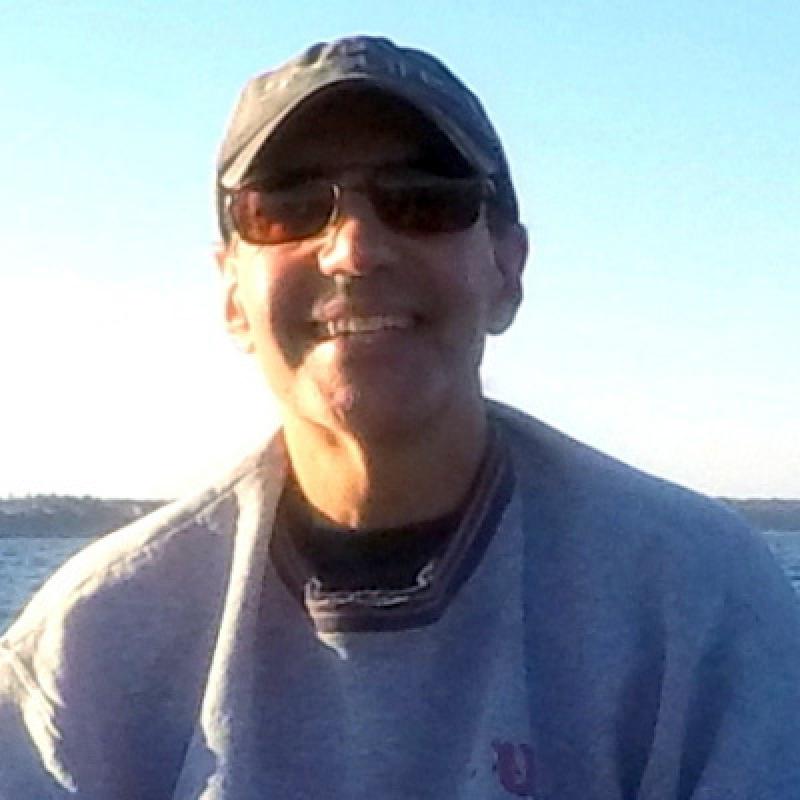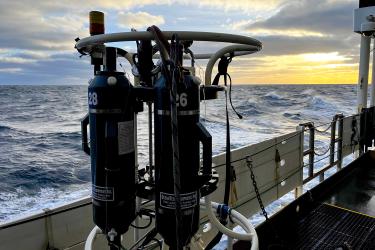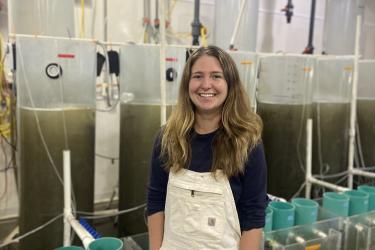This afternoon we made our rendezvous with tropical storm Nestor, but good planning from our vessel command placed us at an inshore station near the mouth of Delaware Bay where the winds and seas were low enough for us to continue working. As I write this, we have just completed our 32nd station and are heading back south, picking up inshore stations with the idea being that we'll be able to continue survey operations in these more sheltered waters as the storm moves away to the north and east.

At the moment however, we are finding conditions to be rather marginal! Ecosystem monitoring surveys have been collecting environmental data at a variety of levels for many years now. Data on water temperature and salinity is collected at every station so we get a detailed profile of the water column. We also collect water from different depths at a subset of stations, and use sensors to measure oxygen, light and chlorophyll levels in the water column.
Through partnerships with collaborators from different institutions we've expanded our observations. The Imaging FlowCytoBot (a kind of underwater microscope) on loan from Woods Hole Oceanographic Institution collects imagery and data on the phytoplankton captured with our scientific seawater flow-through system. This system runs 24 hours a day and collects data on and images of organisms that would be missed by our plankton nets.

A 2018 partnership with the Graduate School of Oceanography at the University of Rhode Island has taken us in still another direction: analyzing how the optical properties of seawater are changed by the phytoplankton that live within it.
Methylmercury: a Toxic Player
This survey marks the start of two new collaborative initiatives: monitoring environmental DNA and traces of methylmercury in the waters of our continental shelf. Patricia Myer, currently on board with us, is a Ph.D student from the University of Connecticut Avery Point campus.
She has kindly written up the following brief description of her research on methylmercury in seawater which I'll include here:
"Methylmercury in both plankton and seawater is measured along the entire cruise track. Methylmercury is the form of mercury that can be absorbed by living things, which is a concern because it is toxic and can be passed up the food chain. Methylmercury enters the food chain primarily through passive uptake into phytoplankton, which eventually results in elevated concentrations in large predatory fish such swordfish and bluefin tuna.
Seawater samples are collected from the flow-through system on board, which pumps water from a depth of 4 meters. Because there is high mixing of surface water during this time of year, these measurements tell us about the chlorophyll maximum, which is actually occurring at depths of tens of meters in this region.
Seawater is filtered sequentially and the plankton caught are separated into three size categories. The plankton are frozen, and the water they came from is preserved, to be analyzed back at the University of Connecticut. This analysis will result in a profile of methylmercury along the northern East Coast, and will be examined for patterns along with physical features to develop a better understanding of methylmercury in the ocean."
eDNA: Tracking Finfish Using What They Leave Behind
The second new initiative on this cruise is our environmental DNA sampling. Yuan Liu from the Northeast Fisheries Science Center’s Milford Laboratory is aboard. Here’s how she describes her pioneering efforts to develop protocols for looking at finfish diversity:

"Water samples are collected to concentrate the DNA in the environment, or eDNA, onto membrane filters. Once DNA is extracted from the filters, we use metabarcoding, a way to rapidly identify species in a mass collection of organisms, to map out the finfish composition in the samples. This is an alternative way of sequencing and has been successfully applied to study finfish assemblages in Long Island Sound. The sampling opportunity provided by the ecosystem monitoring program will enable me to learn if, and how, this technology works on the open ocean off the northeastern United States.
There are three specific questions to be explored: does the amount of seawater filtered affect our detection of species in the finfish community?; does the source of seawater from the same water depth (surface, in this case) affect our fish detection in the finfish community?; what is the vertical profile of the finfish community — which animals live in which layers?"
Yuan Liu's work will give us another tool for monitoring our marine environment. This innovative and novel approach is supported by the NOAA Fisheries Genomics Strategic Initiative.
Light in the Water

The weather has permitted our University of Rhode Island Graduate School of Oceanography contingent to make some radiometry casts. Radiometry is a way to measure electromagnetic radiation, including visible light. The two students have now conducted a couple of successful water-column light measurements with their hand-deployed submersible radiometer, and will be conducting another cast early this afternoon.
A Break in the Weather
The Gordon Gunter is working its way back north to complete the Mid-Atlantic portion of the survey. We are now 55 miles off the coast of Delaware, and facing a sea full of whitecaps and strong winds which have slowed our transit, although we are still able to work. The southern stations had many fish larvae, some juvenile butterfish and flounder, and one bongo tow even captured an adult sand lance!
At the fixed stations where we are collecting water samples there has been an extraordinary amount of activity. On deck there’s a flurry when the water-sampling rosette comes aboard, and researchers are spread out in both the wet and dry labs filtering collected seawater.
Here’s hoping the weather will give us an opportunity for our monitoring to continue!
Jerry Prezioso
Chief Scientist
GU1905 Fall Ecosystem Monitoring Survey



